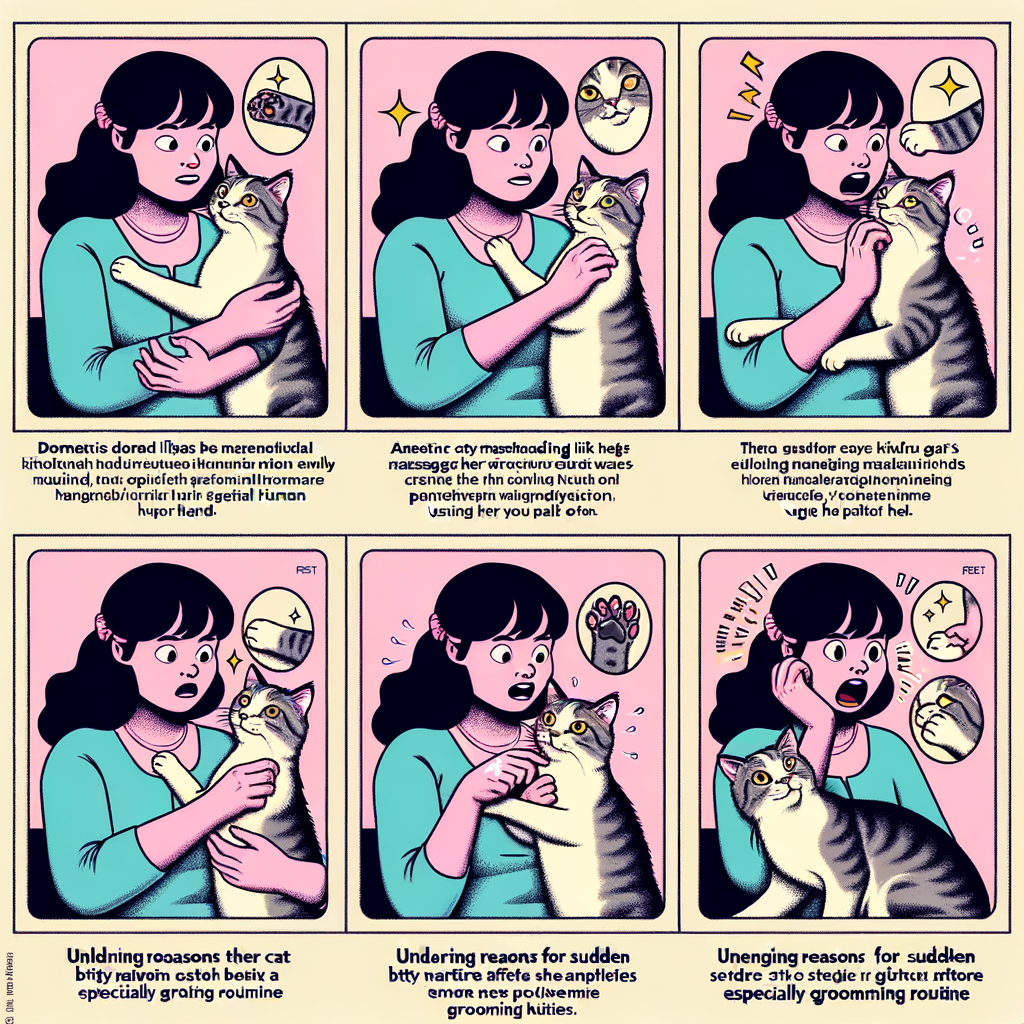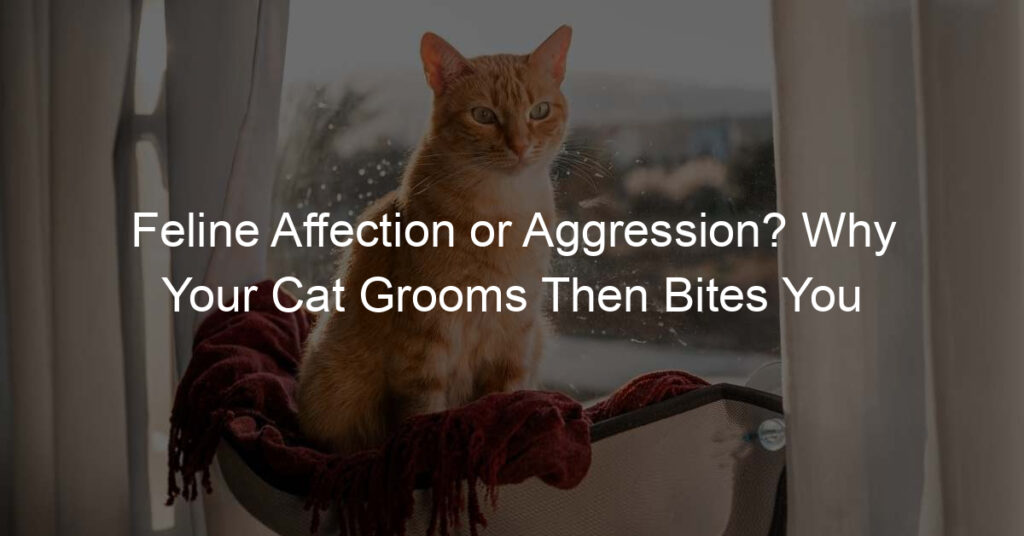
Introduction: Understanding Cat Behavior
Have you ever wondered why your cat behaves the way it does? Cats are mysterious creatures with unique behaviors that can sometimes be hard to understand. In this blog post, we will delve into the fascinating world of cat behavior, focusing on two key aspects: grooming and biting after grooming.
- Overview of Cat Grooming Behavior
- Understanding Why Cats Bite After Grooming
Cats are known for their cleanliness. They spend a significant portion of their day grooming themselves. This behavior, known as allogrooming, is not just about cleanliness but also about bonding and social interaction. Cats groom each other to establish and maintain social bonds. It’s a way for them to show affection and trust.
Have you ever been bitten by your cat after a grooming session? This behavior can be puzzling, but it’s not uncommon. Cats may bite after grooming for several reasons. It could be a form of play, a way to show dominance, or a response to overstimulation. Understanding why your cat bites after grooming can help you better manage this behavior and improve your relationship with your feline friend.
In the following sections, we will delve deeper into these behaviors, providing you with insights and practical tips to help you better understand and interact with your cat. So, whether you’re a new cat owner or a seasoned cat lover, this blog post is for you. Let’s dive in!
Understanding Cat Grooming Behavior
One of the most fascinating aspects of cat behavior is their grooming habits. Cats spend a significant portion of their day grooming themselves, but sometimes, they also groom their human companions. This behavior might seem strange, but it’s a crucial part of their social interaction and a clear sign of affection.
Why Does My Cat Groom Me?
Have you ever wondered why your cat licks your hand or your hair? This behavior is known as allogrooming and it’s more than just a simple grooming habit. Let’s delve into the reasons behind this behavior.
- The social aspect of cat grooming
- How grooming is a sign of affection in cats
Cats are social animals and grooming is a way for them to bond with their group members. In the wild, cats groom each other to strengthen their social bonds. When your cat grooms you, it’s their way of accepting you as a part of their family or group. It’s a sign that they trust you and consider you a part of their social circle.
Another reason why your cat might groom you is to show affection. Cats often groom each other as a form of social bonding. When your cat grooms you, it’s a sign that they care for you and consider you a part of their family. They are showing their love and affection in a way that’s natural to them.
Understanding your cat’s grooming behavior can help you build a stronger bond with your feline friend. It’s a unique way for them to communicate their feelings towards you. So, the next time your cat starts grooming you, remember that it’s their way of showing trust and affection.
Cat Grooming and Aggression
When it comes to our feline friends, it’s crucial to understand their behaviors, particularly when it comes to grooming and aggression. These two behaviors can sometimes seem similar, but they are fundamentally different. Let’s delve into these differences and understand why some cats may show aggression during grooming.
- Understanding the difference between grooming and aggression
- Why some cats may show aggression during grooming
Grooming is a natural behavior for cats. It’s their way of keeping clean, cooling down, and even showing affection. When a cat grooms, it’s usually calm and relaxed. On the other hand, aggression is a defensive behavior. It’s often accompanied by hissing, growling, and physical actions such as biting or scratching. Aggression can be triggered by various factors, including fear, territorial disputes, or discomfort during grooming.
Some cats may show aggression during grooming for several reasons. One common reason is discomfort. If a cat has a sore spot or an underlying health issue, grooming that area can cause pain, leading to aggressive behavior. Another reason could be past traumatic experiences. If a cat has had a negative experience with grooming in the past, it may react aggressively to avoid a repeat of that experience. Understanding these triggers can help you make grooming a more positive experience for your cat.
In conclusion, it’s essential to understand the difference between grooming and aggression in cats. By recognizing the signs of each, you can better respond to your cat’s needs and ensure a positive grooming experience. Remember, if your cat shows aggression during grooming, it’s likely trying to communicate discomfort or fear. It’s our responsibility as pet owners to understand and address these concerns.
Why Does My Cat Bite Me After Grooming?
Have you ever wondered why your cat bites you after grooming? It can be a puzzling and sometimes painful experience. But don’t worry, this behavior is not uncommon and there are several reasons why this might be happening.
Reasons for Cat Bites
Let’s delve into the main reasons why your feline friend might bite you after grooming:
- Overstimulation during grooming: Cats have a high sensitivity to touch. Too much stroking or brushing can lead to overstimulation, causing them to bite as a way to communicate that they’ve had enough.
- Playful behavior or hunting instincts: Cats are natural hunters and sometimes, biting is just a part of their playful behavior. They might see your moving hands as ‘prey’ and bite them in a playful manner.
- Health issues or discomfort: If your cat is experiencing any health issues or discomfort, they might bite you to show their discomfort. This could be due to skin conditions, parasites, or other health problems. If you notice this behavior along with other signs of illness, it’s best to consult with a vet.
Understanding these reasons can help you better manage your cat’s behavior and ensure a more enjoyable grooming experience for both of you.
Understanding Cat Biting Habits
As cat owners, it’s important to understand why our feline friends may resort to biting. This behavior can be a part of their normal routine, or it could be a sign of a problem. Let’s delve into these two aspects.
- How biting can be a part of normal cat behavior
- When biting may be a sign of a problem
Cats, like their wild counterparts, are natural hunters. Biting is a part of their instinctual behavior. When they play, they may bite as a way to practice their hunting skills. It’s also a way for them to communicate. A gentle bite can be a sign of affection, known as a ‘love bite’. However, it’s important to note that even in play, the biting should not be hard or cause discomfort.
On the other hand, biting can also be a sign of a problem. If your cat’s biting becomes more aggressive or frequent, it could be a sign of stress or fear. It could also indicate a health issue. For instance, if your cat is biting a specific area on their body excessively, they could be experiencing pain or discomfort there. In such cases, it’s important to consult with a veterinarian.
In conclusion, while biting can be a part of normal cat behavior, it’s crucial to keep an eye on this habit. Any changes in the intensity, frequency, or target of the biting should be taken seriously. Remember, understanding your cat’s behavior is the first step towards ensuring their well-being.
How to Respond to Cat Biting After Grooming
Understanding how to respond to your cat’s biting behavior after grooming can be a challenge. However, with the right approach, you can help your feline friend feel more comfortable and reduce the likelihood of biting. Here are some practical tips to guide you.
Practical Tips for Handling Cat Grooming and Biting
There are several strategies you can use to manage your cat’s grooming and biting behavior. Let’s explore them in detail.
- How to respond when your cat bites you
When your cat bites you after grooming, it’s important not to react aggressively. Instead, remain calm and slowly move your hand away. You can also distract your cat with a toy or treat. Remember, your cat is not trying to hurt you – it’s just their way of communicating discomfort or stress.
- Training techniques to discourage biting
Training your cat to stop biting involves patience and consistency. Start by rewarding your cat for calm behavior during grooming sessions. You can use treats, praises, or petting as rewards. If your cat starts to bite, stop the grooming session immediately. Over time, your cat will associate calm behavior with rewards and biting with the end of grooming.
- When to seek professional help
If your cat’s biting behavior continues despite your best efforts, it may be time to seek professional help. A professional cat behaviorist or a veterinarian can provide further guidance and help identify any underlying issues that may be causing the biting.
In conclusion, dealing with cat biting after grooming requires understanding, patience, and consistency. By responding calmly to bites, rewarding good behavior, and seeking professional help when necessary, you can make grooming a more pleasant experience for both you and your cat.
Conclusion: Cat Behavior Explained
As we wrap up our discussion on cat behavior, particularly focusing on grooming and biting, it’s important to remember that each cat is unique. Their behaviors are shaped by their experiences, environment, and innate instincts. Understanding these behaviors can help you build a stronger bond with your feline friend.
- Key takeaways about cat grooming and biting
- Understanding your cat’s unique behavior
Cat grooming is a natural behavior that serves multiple purposes. It helps cats clean themselves, regulate their body temperatures, and even bond with their human companions. However, biting after grooming can be a sign of overstimulation or discomfort. It’s crucial to observe your cat’s body language and respect their boundaries to prevent biting incidents.
Every cat is unique and has its own set of behaviors. Some cats might enjoy long grooming sessions, while others might prefer shorter ones. Some might bite gently as a sign of affection, while others might bite harder to signal that they’ve had enough. Understanding your cat’s unique behavior is key to building a strong, respectful relationship with them.
Remember, patience and understanding are key when dealing with your feline friend. It might take time to fully understand their behaviors, but the bond you’ll form with them will be worth it. After all, a well-understood cat is a happy cat!
| Behavior | Meaning |
|---|---|
| Grooming | Cleaning, temperature regulation, bonding |
| Biting after grooming | Overstimulation, discomfort |
Understanding your cat’s behavior is a journey, not a destination. Keep observing, keep learning, and most importantly, keep loving your feline friend!








